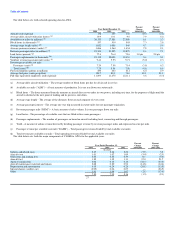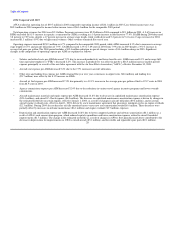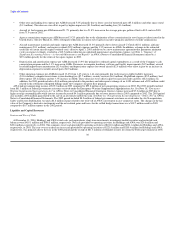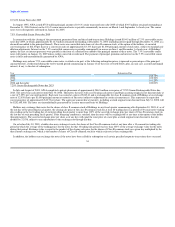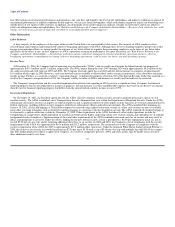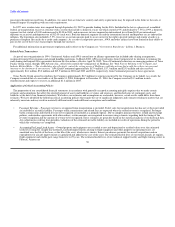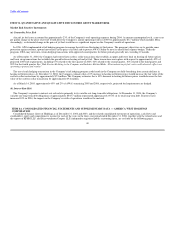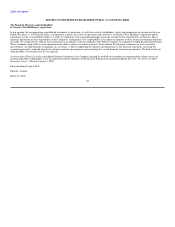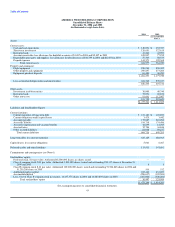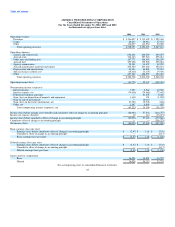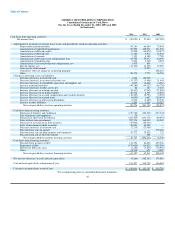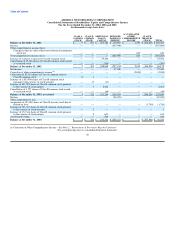US Airways 2004 Annual Report Download - page 40
Download and view the complete annual report
Please find page 40 of the 2004 US Airways annual report below. You can navigate through the pages in the report by either clicking on the pages listed below, or by using the keyword search tool below to find specific information within the annual report.
Table of Contents
base their ratings on our financial performance and operations, our cash flow and liquidity, the level of our indebtedness and industry conditions in general. If
our financial performance or industry conditions do not improve, we may face future downgrades, which could further negatively impact our borrowing costs
and the prices of our equity or debt securities. In addition, any downgrade of our credit ratings may indicate a decline in our business and in our ability to
satisfy our obligations under our indebtedness. See "Risk Factors Relating to the Company and Industry Related Risks — Because of our relatively low credit
ratings, our borrowing costs may be high and our ability to incur additional debt may be impaired."
Other Information
Labor Relations
A large majority of the employees of the major airlines in the United States are represented by labor unions. The majority of AWA employees have
selected union representation and/or negotiated collective bargaining agreements with AWA. Although there are few remaining employee groups who could
engage in organization efforts, we cannot predict the outcome of any future efforts to organize those remaining employees or the terms of any future labor
agreements or the effect, if any, on the Company's or AWA's operations or financial performance. For more discussion, see "Risk Factors Relating to the
Company and Industry Related Risks — Negotiations with labor unions could divert management attention and disrupt operations and new collective
bargaining agreements or amendments to existing collective bargaining agreements could increase our labor costs and operating expenses."
Income Taxes
At December 31, 2004, the Company had net operating loss carryforwards ("NOLs") and tax credit carryforwards for federal income tax purposes of
approximately $451.4 million and $1.1 million, respectively. The NOLs expire during the years 2007 through 2024 while approximately $0.2 million of the
tax credit carryforwards will expire in 2005 and 2006. The Company also had capital loss carryforwards for federal income tax purposes of approximately
$1.4 million which expire in 2009. However, such carryforwards are not available to offset federal (and in certain circumstances, state) alternative minimum
taxable income. Further, as a result of a statutory "ownership change" (as defined for purposes of Section 382 of the Internal Revenue Code) that occurred as a
result of the Company's reorganization in 1994, the Company's ability to utilize its NOLs and business tax credit carryforwards may be restricted.
The Company's reorganization and the associated implementation of fresh start reporting in 1994 gave rise to significant items of expense for financial
reporting purposes that are not deductible for income tax purposes. In large measure, it is these nondeductible expenses that result in an effective tax expense
(benefit) rate for financial reporting purposes that differs from the current federal statutory income tax rate of 35%.
Government Regulations
On November 19, 2001, the President signed into law the ATSA. This law enhances aviation security measures and federalizes many aspects of civil
aviation security. The ATSA established a new Transportation Security Administration, now within the Department of Homeland Security. Under the ATSA,
substantially all security screeners at airports are federal employees and a significant number of other airport security functions are overseen and performed by
federal employees, including federal security managers, federal law enforcement officers and federal air marshals. The ATSA mandated that beginning on
January 18, 2002, all checked baggage at United States airports be screened using explosive detection systems or, where such systems are not yet available,
using other screening techniques such as positively matching baggage to a passenger who has boarded an aircraft. The ATSA required all checked baggage to
be screened by explosive detection systems by December 31, 2003. Other requirements in the ATSA that directly affect airline operations include the
strengthening of cockpit doors, deploying federal air marshals on board certain flights, improving airline crew security training and expanding use of criminal
background checks of employees. Implementation of these and other requirements of the ATSA resulted in increased costs for air carriers and may result in
delays and disruptions to air travel. Under the ATSA, funding for the new federal security system is provided by a $2.50 per enplanement ticket tax, not to
exceed $5.00 per one-way trip, and by imposing additional direct fees on air carriers. In 2004 and 2003, the Company's cost of compliance with the security
requirements of the ATSA was approximately $14.4 million and $13.2 million, respectively. The estimated cost to the Company of compliance with the
security requirements of the ATSA for 2005 is approximately $17.0 million under current law. Under the proposed White House budget released February 7,
2005, this ticket tax for security fees would increase from $2.50 per leg to $5.50 with a cap of $8.00 one-way trip with multiple legs and $16.00 for a round
trip. This budget proposal is subject to approval of Congress. As a result of competitive pressure, AWA and other airlines may be unable to recover all of
these additional security costs from
37


